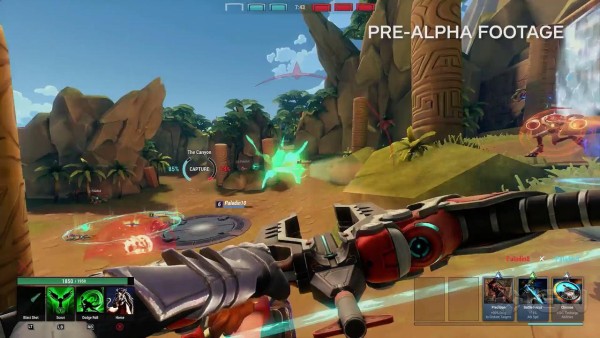An arena shooter with character
We’re in the midst of watching the birth of a new genre. Just as MOBAs sprung from realtime strategy games, a new breed of character-based first-person games is springing up from what came before. At Gamescom, Gearbox’s Battleborn and Blizzard’s Overwatch were joined by a third entry in this as-yet unnamed category.
Hi-Rez’s Paladins (and its compatriots) borrow the character-driven aspect of MOBAs. Instead of classes like those found in Team Fortress 2 though, each hero has his or her own weapons and skills. Like its progenitor genre, Paladins features an in-game leveling curve that starts at one for each match.
Where Paladins innovates is its progression system. Prior to play, you create a deck of collectible cards. These can boost your primary attack, one of your two skills, movement ability, or have a passive benefit.
Each time you fill your experience meter, three cards are drawn from your deck. You can choose one, with the others shuffled back in. Each has five different potencies, depending on when they are added to your “hand.” Cards don’t level up, so the one you select at level one will remain at the lowest tier. At level two, your next card will be fixed at the next tick up, and so on.
The in-match level cap is nine, which means that starting at level six, your base cards are automatically upgraded from their original potency to maximum strength. Strategy plays a role in choosing your cards. Do you add a powerful card immediately (and at a lower level), or hope that it comes around again later?
Gameplay in Paladins is fast-paced objective capture. During the match, players swarm to the one active point to fill their team’s meter and spawn a siege engine. These mammoth vehicles are the only way to take down the enemy’s gates and ultimately its base.
The combination of objective points and siege engines grinding their wheels across the terrain keeps players engaged in firefights, even within open maps. Paladins inspires players to back off fights when low on health, just like MOBAs do. Health begins to regenerate once you’re out of combat for a short time. Firing resets that timer, so committing to a retreat is important. Should you die, you wait to respawn. When you return your cards are on cooldown. The higher level the card, the longer you have to wait for it to reactivate.
This creates an exciting risk/reward feel to combat. Hi-Rez is building in a catch-up mechanic so that matches stay competitive all the way through. If your team is losing, you respawn and capture objectives points faster. Given that the game is in pre-alpha, this is all still being tuned.
For a game so early in development, Paladins played well. We can’t wait to see how Hi-Rez evolves the design and gameplay on the road to public testing some time before the end of 2015. Michael Futter

